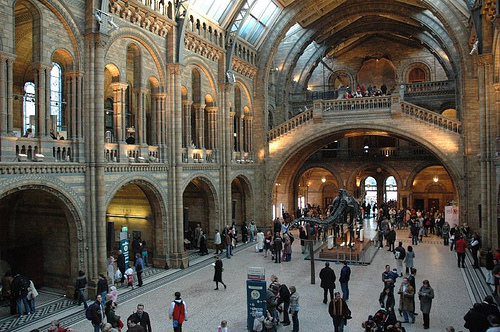The Natural History Museum
The Natural History Museum is one of the three large museums in London. The other two are the Victoria and Albert Museum and the Science Museum. The museum is the home of the earth and life science specimens which make up some 70 million items within five main collections which include Zoology, Paleontology, Mineralogy, Entomology, and Botany. The museum is a known the world over as a center of research, specializing in conservation, identification and taxonomy. Given the age of the institution, many of the collections have great historical as well as scientific value, such as the specimens that were collected by Darwin. The Natural History Museum Library contains extensive artwork, manuscript, journal, and book collections linked to the research and work of the scientific departments.

The museum is uniquely famous for its exhibition of ornate architecture and dinosaur skeletons and both are typified by the enormous Diplodocus cast which hangs from the vaulted central hall.
In 1881 the Alfred Waterhouse building opened with collections that originated from within the British Museum, and later incorporated the Geological Museum. The Darwin Centre is a more recent addition and is designed partly as a modern facility for valuable collection storage.
Certainly one of the most prominent and famous exhibits is a long replica of Diplodocus carnegii skeleton which is 105 foot (32 m) long and located within the central hall and known affectionately as Dippy. The cast was given by Andrew Carnegie, after several long discussions with King Edward VII. At his own considerable expense of £2000 Carnegie had the cast to be created by copying the original held at the Carnegie Museum.
On the 12th May 1905, the exhibit was unveiled to great public and media interest. Mr. Carnegie paid to have more copies made for display in most of the major European capitals and in South and Latin America, which made Dippy the most popular dinosaur skeleton in the world. The dinosaur has been featured in many cartoons and other media, including the 1975 Disney comedy One of Our Dinosaurs Is Missing.
Another iconic display is the parallel model and skeleton a blue whale. The display of the skeleton, which is some 25 m long and weighs 10 tons, was only made possible in 1934 with the building of the New Whale Hall. Around this time discussions of the idea of a full sized model and from within the Whale Hall itself, work was finally undertaken. Scale models were used to tediously put the structure together since it was prohibitively expensive to take a cast of such a large animal.

